Evaluation of Various Turbulence Models and Large Eddy Simulation for Stall Prediction in a Centrifugal Pump
Abstract
:1. Introduction
2. Turbulence Model
2.1. Wray-Agarwal (WA) Turbulence Model
2.2. Large Eddy Simulation (LES) Method
3. Computational Model and Methods
3.1. Computational Model
3.2. Meshing and Boundary Conditions
3.3. Mesh Independence Verification
3.4. Experimental Model
4. Results and Discussion
4.1. Internal Flow Field Analysis
4.2. Vorticity and Vortex Intensity Analysis
5. Conclusions
- Among the five turbulence models, LES has the best agreement with the experimental data. The WA model shows strong potential for accurately computing the stall. The reason is that the WA model adds a cross-diffusion term to the eddy viscosity R equation, so that the model can behave as a one-equation k−ω model in the near-wall region or as one-equation k−ε model away from the wall by employing a switching function. The WA model can also accurately predict flow separation under adverse pressure gradients.
- LES and the WA model are more accurate than the other models in simulating the flow patterns in the non-stall channel, with the results being highly consistent with the test data. The reason is that the other three models except the LES and WA model do not consider the effect of pre-rotation in the non-stall channel. The LES model predicts the best overlap of stall cell and velocity distribution in the stall channel with the PIV test results. The stall cell position predicted by the WA model is slightly different from that in the PIV experiment, but the calculation results are still better than those from the realizable k−ε, RNG k−ε and SST k−ω models.
- The Z-directional vorticity magnitudes predicted by all five models are slightly larger than the test data, but two regions with high vorticity values are successfully predicted. The WA model has good agreement with the experiment in predicting the size and range of stall cells in the non-stall channel; all other models have different degrees of overestimation. In general, the WA model can accurately predict the vorticity distribution in the impeller passage. The inlet reflux vortex simulated using the WA model is located above the stall channels, while the simulation results of other models are located above the non-stall channels. The LES model recognition of vortex structures on the same iso-surface is better.
Author Contributions
Funding
Data Availability Statement
Conflicts of Interest
References
- Emmons, H.; Pearson, C.; Grant, H. Compressor surge and stall propagation. Trans. Am. Soc. Mech. Eng. 1995, 77, 455–467. [Google Scholar] [CrossRef]
- Li, W.; Yang, Z.; Shi, W.; Li, E.; Ji, L. Research progress of non-uniform inflow of water jet pump. J. Drain. Irrig. Mach. Eng. 2022, 40, 757–765. [Google Scholar]
- Krause, N.; Zähringer, K.; Pap, E. Time-resolved particle imaging velocimetry for the investigation of rotating stall in a radial pump. Exp. Fluids 2005, 39, 192–201. [Google Scholar] [CrossRef]
- Pedersen, N.; Larsen, P.; Jacobsen, C. Flow in a centrifugal pump impeller at design and off-design conditions—Part I: Particle image velocimetry (PIV) and laser Doppler velocimetry (LDV) measurements. J. Fluids Eng. 2003, 125, 61–72. [Google Scholar] [CrossRef]
- Ullum, U.; Wright, J.; Dayi, O.; Ecder, A.; Soulaimani, A.; Piché, R.; Kamath, H. Prediction of rotating stall within an impeller of a centrifugal pump based on spectral analysis of pressure and velocity data. J. Phys. Conf. Ser. 2006, 52, 36–45. [Google Scholar] [CrossRef]
- Liu, T.; Zhang, Y.; Du, X. A review of rotating stall of pump turbines. J. Hydroelectr. Eng. 2015, 34, 16–24. [Google Scholar]
- Zhao, B.; Liu, Y.; Han, L.; Cao, K.; Chen, H.; Huang, Z. Vortex identification and its evolution law of mixed-flow pump under low-flow condition. J. Drain. Irrig. Mach. Eng. 2023, 41, 231–238. [Google Scholar]
- Zhang, N.; Yang, M.G.; Gao, B. Unsteady rotating stall characteristics in a centrifugal pump with slope volute at low flow rates. J. Vib. Shock 2015, 34, 189–194. [Google Scholar]
- Tang, P.; Li, H.; Issaka, Z.; Chen, C. Effect of manifold layout and fertilizer solution concentration on fertilization and flushing times and uniformity of drip irrigation systems. Agric. Water Manag. 2018, 200, 71–79. [Google Scholar] [CrossRef]
- Issaka, Z.; Li, H.; Jiang, Y.; Tang, P.; Chao, C. Comparison of rotation and water distribution uniformity using dispersion devices for impact and rotary sprinklers. Irrig. Drain. 2019, 68, 881–892. [Google Scholar] [CrossRef]
- Zhou, L.; Bai, L.; Li, W.; Shi, W.; Wang, C. PIV validation of different turbulence models used for numerical simulation of a centrifugal pump diffuser. Eng. Comput. 2018, 35, 2–17. [Google Scholar] [CrossRef]
- Yang, Y.; Zhou, L.; Shi, W.; He, Z.; Han, Y.; Xiao, Y. Interstage difference of pressure pulsation in a three-stage electrical submersible pump. J. Pet. Sci. Eng. 2021, 196, 107653. [Google Scholar] [CrossRef]
- Zhou, L.; Hang, J.; Bai, L.; Krzemianowski, Z.; El-Emam, M.A.; Yasser, E.; Agarwal, R. Application of entropy production theory for energy losses and other investigation in pumps and turbines: A review. Appl. Energy 2022, 318, 119211. [Google Scholar] [CrossRef]
- Innocenti, A.; Jaccod, A.; Popinet, S.; Chibbaro, S. Direct numerical simulation of bubble-induced turbulence. J. Fluid Mech. 2021, 918, A23. [Google Scholar] [CrossRef]
- Tucker, P. Unsteady Computational Fluid Dynamics in Aeronautics; Springer Science & Business Media: Berlin/Heidelberg, Germany, 2014; 104p. [Google Scholar]
- Smagorinsky, J. General circulation experiments with the primitive equations: I. Basic Exp. Mon. Weather Rev. 1963, 91, 99–164. [Google Scholar] [CrossRef]
- Li, W.; Zhou, L.; Shi, W.; Ji, L.; Yang, Y.; Zhao, X. PIV experiment of the unsteady flow field in mixed-flow pump under part loading condition. Exp. Therm. Fluid Sci. 2017, 83, 191–199. [Google Scholar] [CrossRef]
- El-Emam, M.; Zhou, L.; Yasser, E.; Bai, L.; Shi, W. Computational methods of erosion wear in centrifugal pump: A state-of-the-art review. Arch. Comput. Methods Eng. 2022, 29, 3789–3814. [Google Scholar] [CrossRef]
- Wilcox, D.C. Turbulence Modeling for CFD; D.C.W. Industries: La Canada, CA, USA, 1998; pp. 103–217. [Google Scholar]
- Zhang, Y.; Zang, W.; Zheng, J.; Cappietti, L.; Zhang, J.; Zheng, Y.; Fernandez-Rodriguez, E. The influence of waves propagating with the current on the wake of a tidal stream turbine. Appl. Energy 2021, 290, 116729. [Google Scholar] [CrossRef]
- Mousavi, S.; Hosseini, K.; Fouladfar, H.; Mohammadian, M. Comparison of different turbulence models in predicting cohesive fluid mud gravity current propagation. Int. J. Sediment Res. 2020, 35, 504–515. [Google Scholar]
- Chen, Q. Prediction Performance of Several Turbulence Models in Flows Pertinent to Turbomachinery. Master’s Thesis, Tsinghua University, Beijing, China, 2007. [Google Scholar]
- Zhang, W. Analysis and Predicition of the Internal Flow in the Vane Pump Impeller at Off Design Condition. Ph.D. Thesis, Shanghai University, Shanghai, China, 2010. [Google Scholar]
- Ji, L.; Li, W.; Shi, W.; Agarwal, R. Application of Wray–Agarwal turbulence model in flow simulation of a centrifugal pump with semispiral suction chamber. ASME J. Fluids Eng. 2021, 143, 031203. [Google Scholar] [CrossRef]
- Han, X.; Rahman, M.; Agarwal, R. Development and application of wall-distance-free Wray-Agarwal turbulence model. In Proceedings of the AIAA Aerospace Sciences Meeting, Kissimmee, FL, USA, 8–12 January 2018. [Google Scholar]
- Wray, T.; Agarwal, R. Low-Reynolds-number one-equation turbulence model based on k−ω closure. AIAA J. 2015, 53, 2216–2227. [Google Scholar] [CrossRef]
- Yang, H.; Agarwal, R. CFD simulations of a triangular airfoil for Martian atmosphere in low-reynolds number compressible flow. In Proceedings of the AIAA Aviation 2019 Forum, Dallas, TX, USA, 17–21 June 2019. [Google Scholar]
- Wray, T.J. Development of a One-Equation Eddy Viscosity Turbulence Model for Application to Complex Turbulent Flows; Washington University: St. Louis, MO, USA, 2016. [Google Scholar]
- Rahman, M.; Agarwal, R.; Siikonen, T. RAS one-equation turbulence model with non-singular eddy-viscosity coefficient. Int. J. Comput. Fluid Dyn. 2016, 30, 89–106. [Google Scholar] [CrossRef]
- Han, Y.; Zhou, L.; Bai, L.; Shi, W.; Agarwal, R. Comparison and validation of various turbulence models for U-bend flow with a magnetic resonance velocimetry experiment. Phys. Fluids 2021, 33, 125117. [Google Scholar] [CrossRef]
- Ouyang, Y.; Tang, K.; Xiang, Y.; Zou, H.; Chu, G.; Agarwal, R.K.; Chen, J.F. Evaluation of various turbulence models for numerical simulation of a multiphase system in a rotating packed bed. Comput. Fluids 2019, 194, 104296. [Google Scholar] [CrossRef]
- Pedersen, N. Experimental Investigation of Flow Structures in a Centrifugal Pump Impeller Using Particle Image Velocimetry. Ph.D. Thesis, Technical University of Denmark, Lyngby, Denmark, 2000. [Google Scholar]
- Zhang, W.; Yu, Y.; Chen, H. Numerical simulation of flow in centrifugal pump Impeller at off-design conditions. J. Drain. Irrig. Mach. Eng. 2010, 1, 38–42. [Google Scholar]
- Wen, T.; Agarwal, R.K. A new extension of wray-agarwal wall distance free turbulence model to rough wall flows. In Proceedings of the AIAA Scitech 2019 Forum, San Diego, CA, USA, 7–11 January 2019. [Google Scholar]
- Germano, M.; Piomelli, U.; Moin, P.; Cabot, W. A dynamic subgrid-scale eddy viscosity model. Phys. Fluids A Fluid Dyn. 1991, 3, 1760–1765. [Google Scholar] [CrossRef]
- Lilly, D.K. A proposed modification of the Germano subgrid-scale closure method. Phys. Fluids A: Fluid Dyn. 1992, 4, 633–635. [Google Scholar] [CrossRef]
- Byskov, R.; Jacobsen, C.; Pedersen, N. Flow in a centrifugal pump impeller at design and off-design conditions—Part II: Large eddy simulations. J. Fluids Eng. 2003, 125, 73–83. [Google Scholar] [CrossRef]
- Feng, J.; Wang, C.; Luo, X. Rotating stall in centrifugal pump impeller under part-load conditions. J. Hydroelectr. Eng. 2018, 37, 117–124. [Google Scholar]
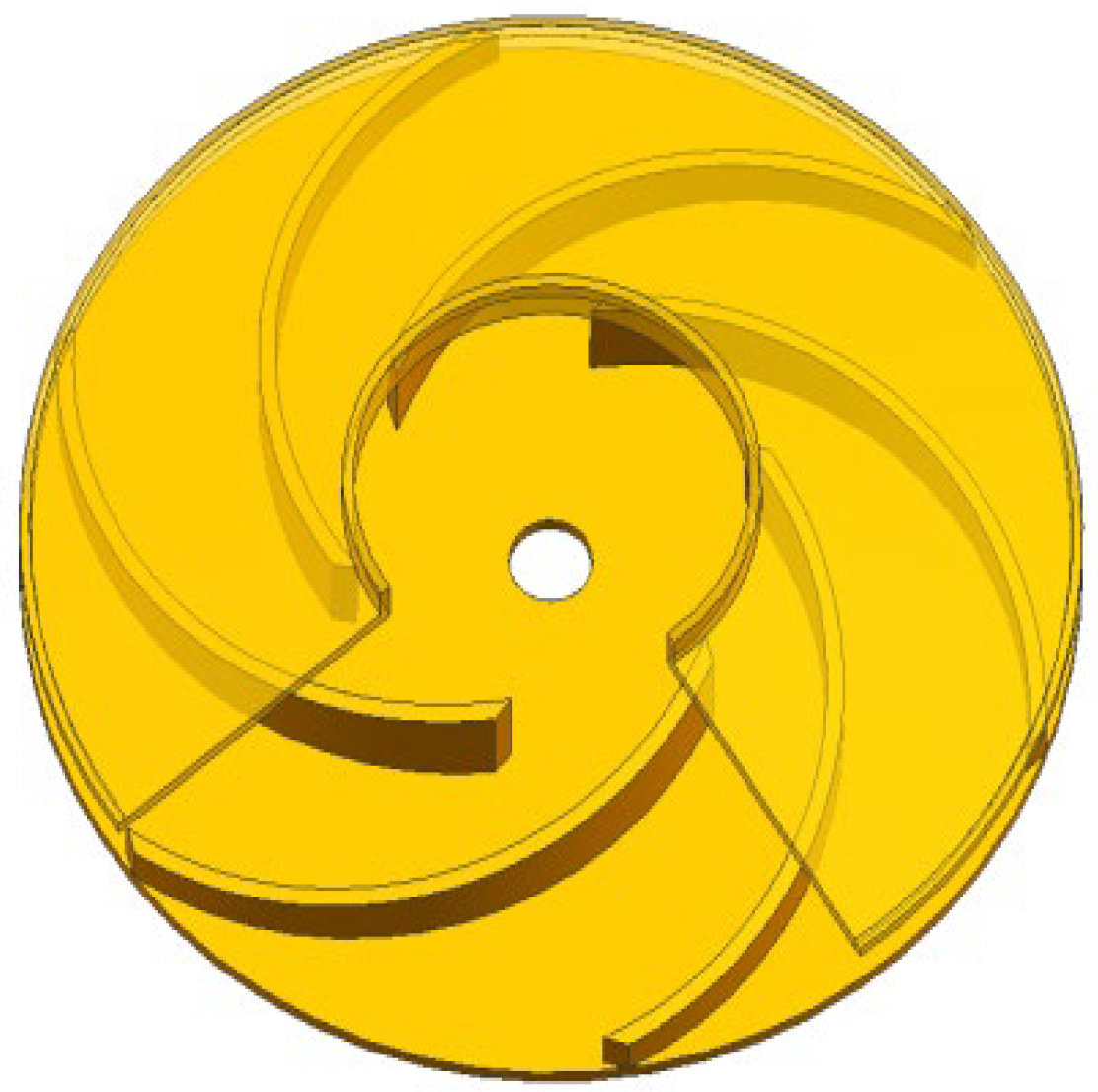
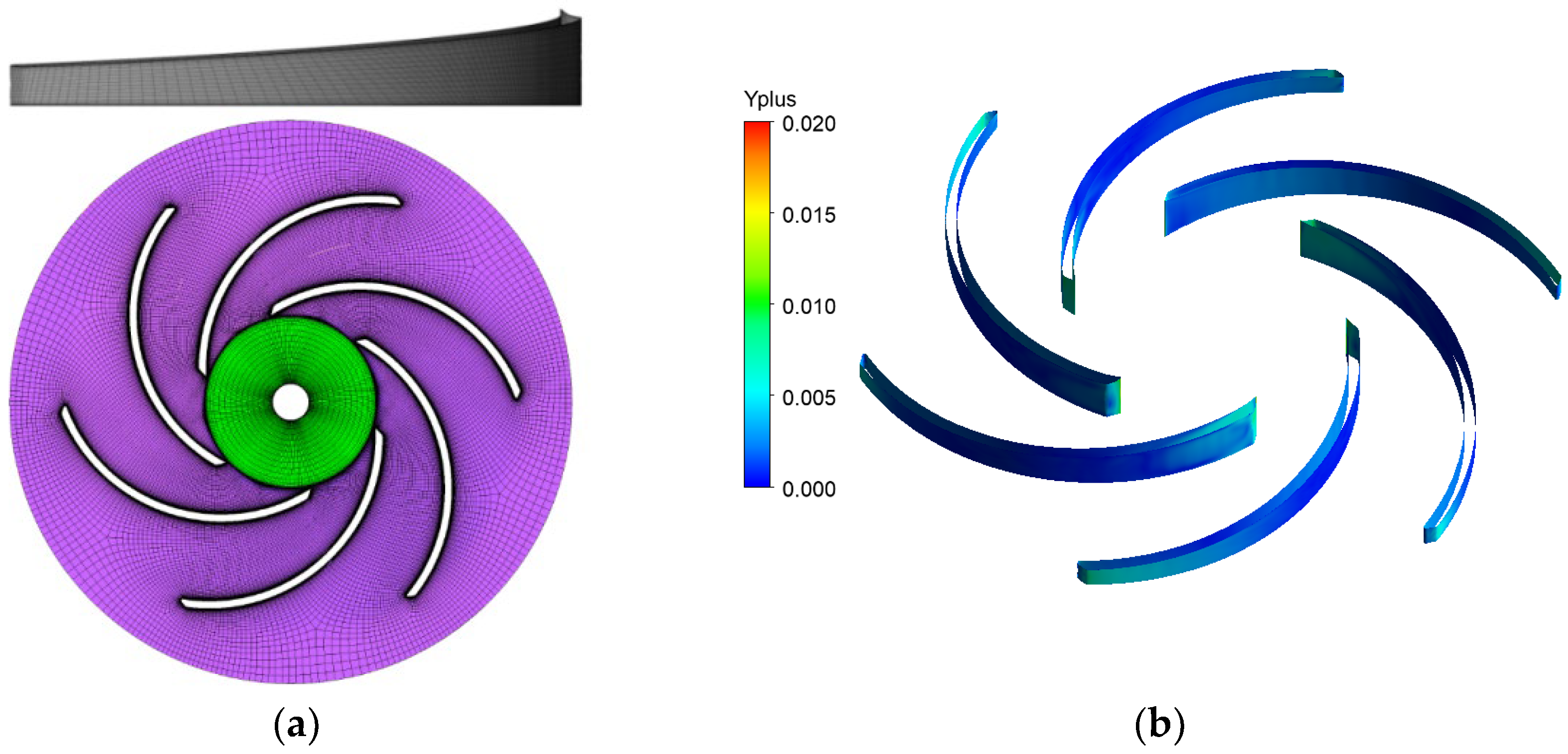
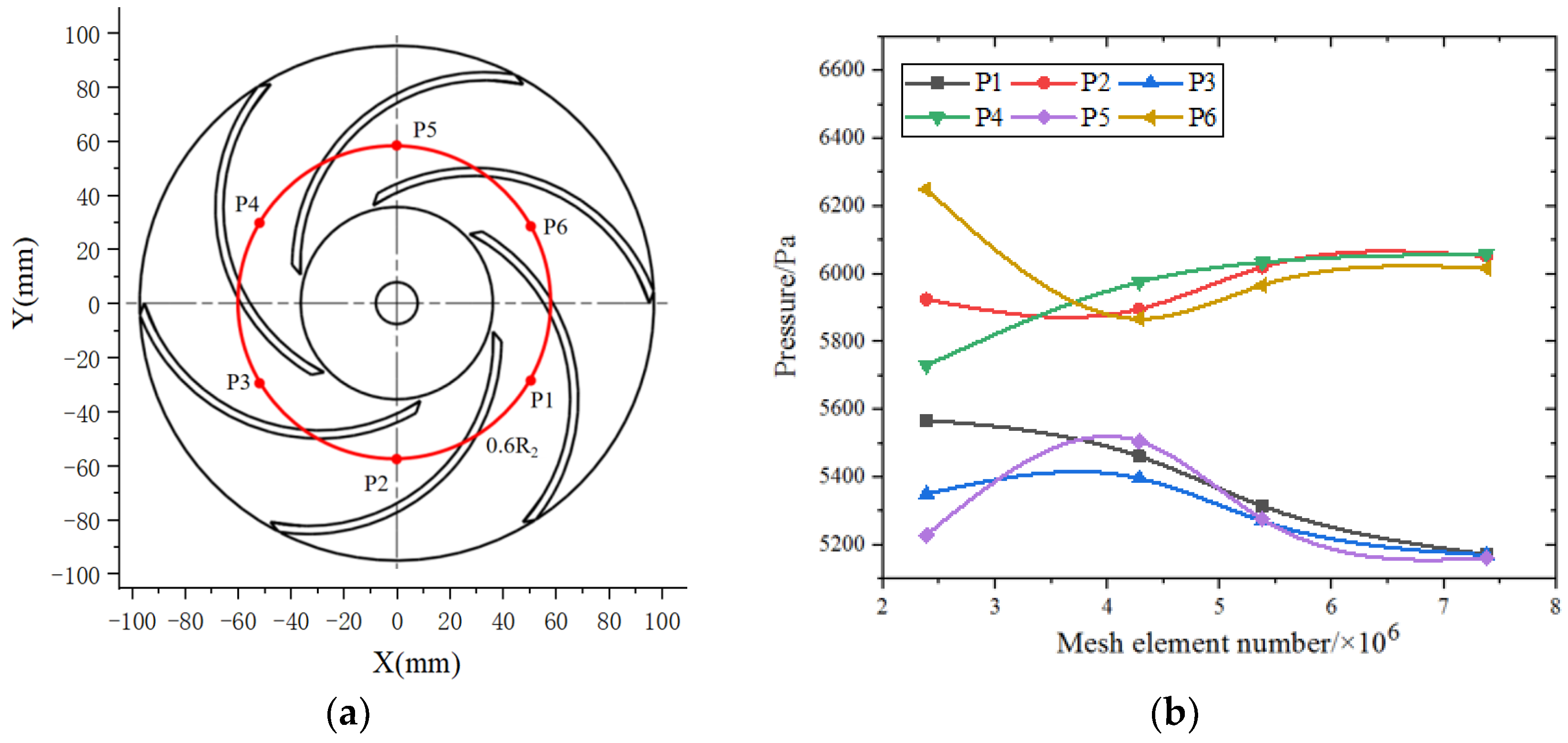
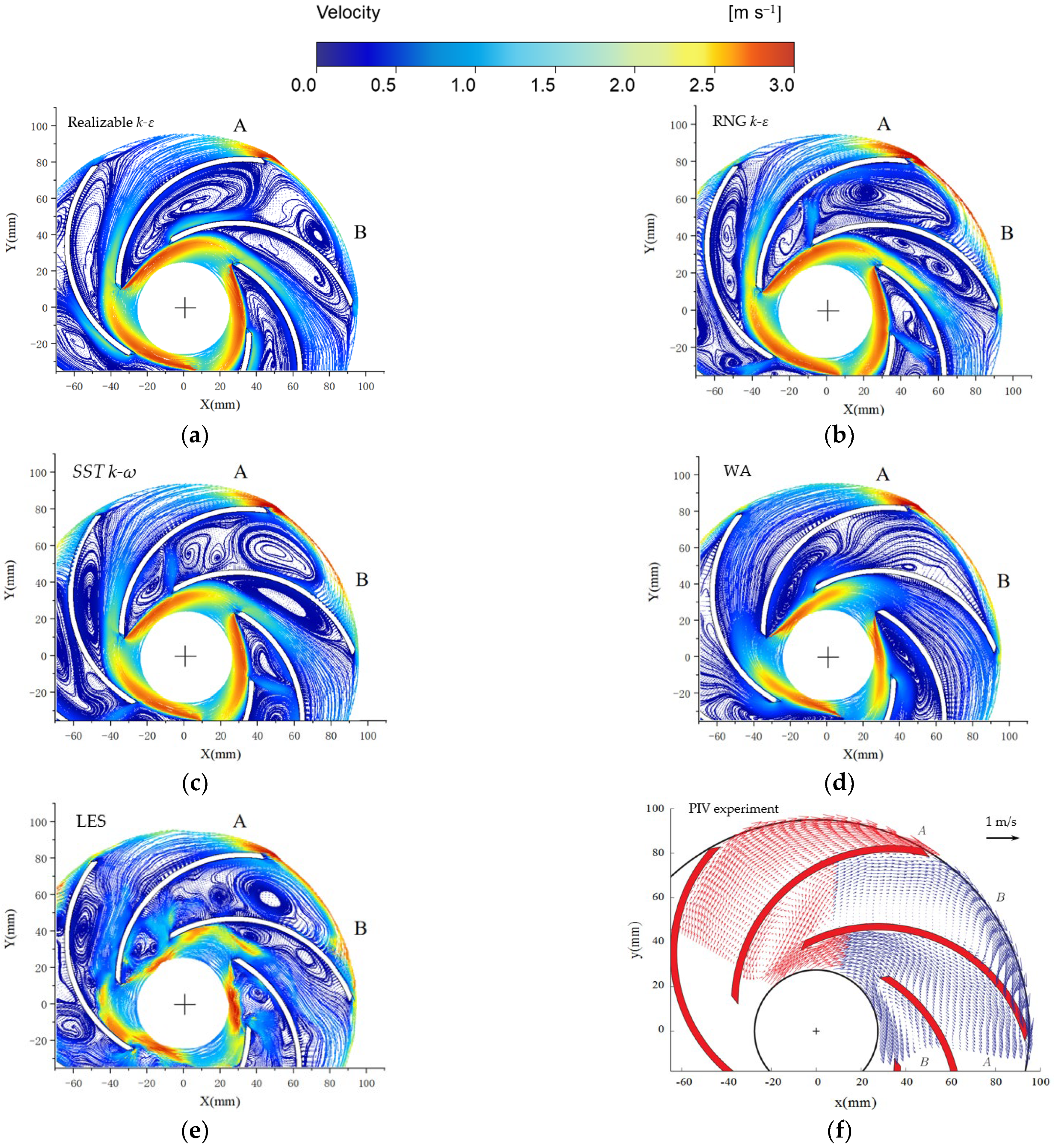



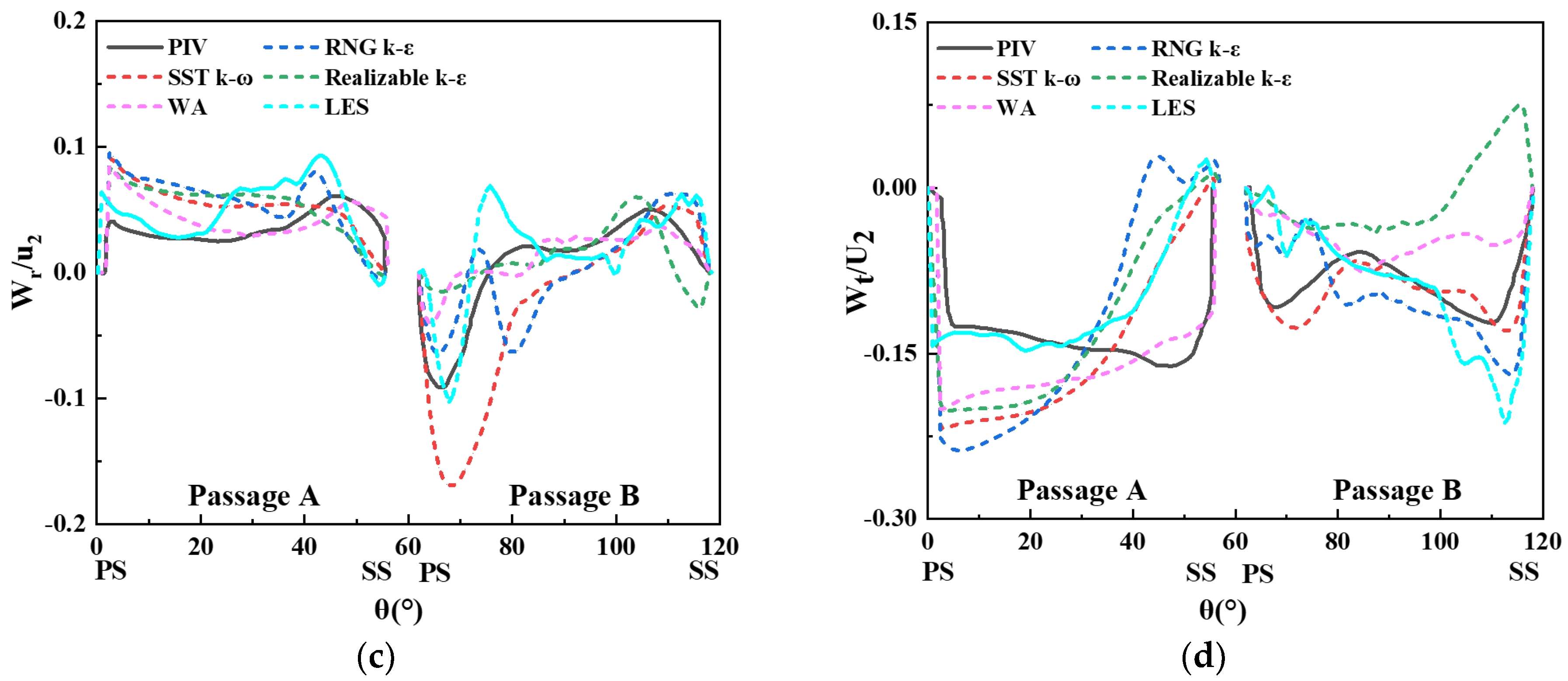
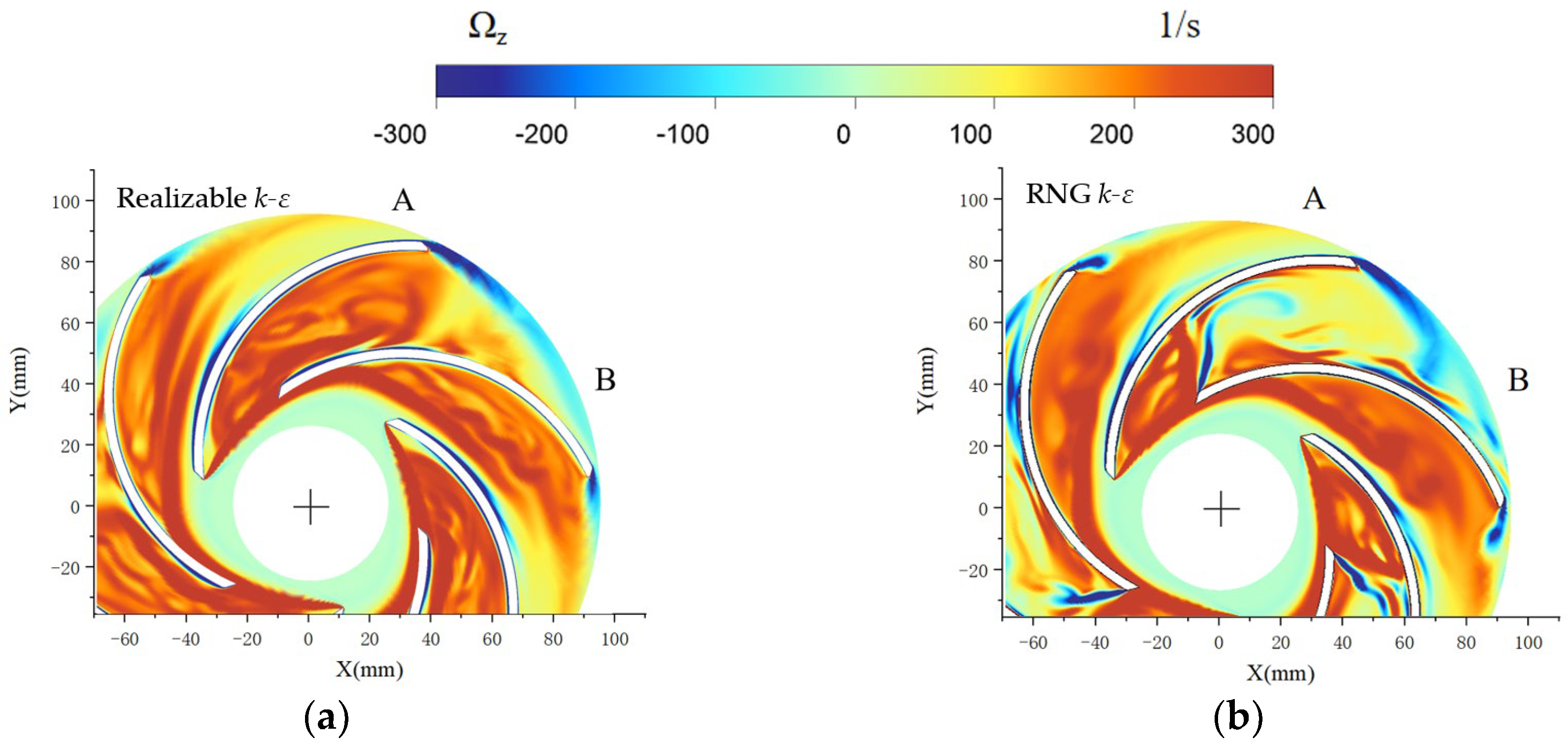
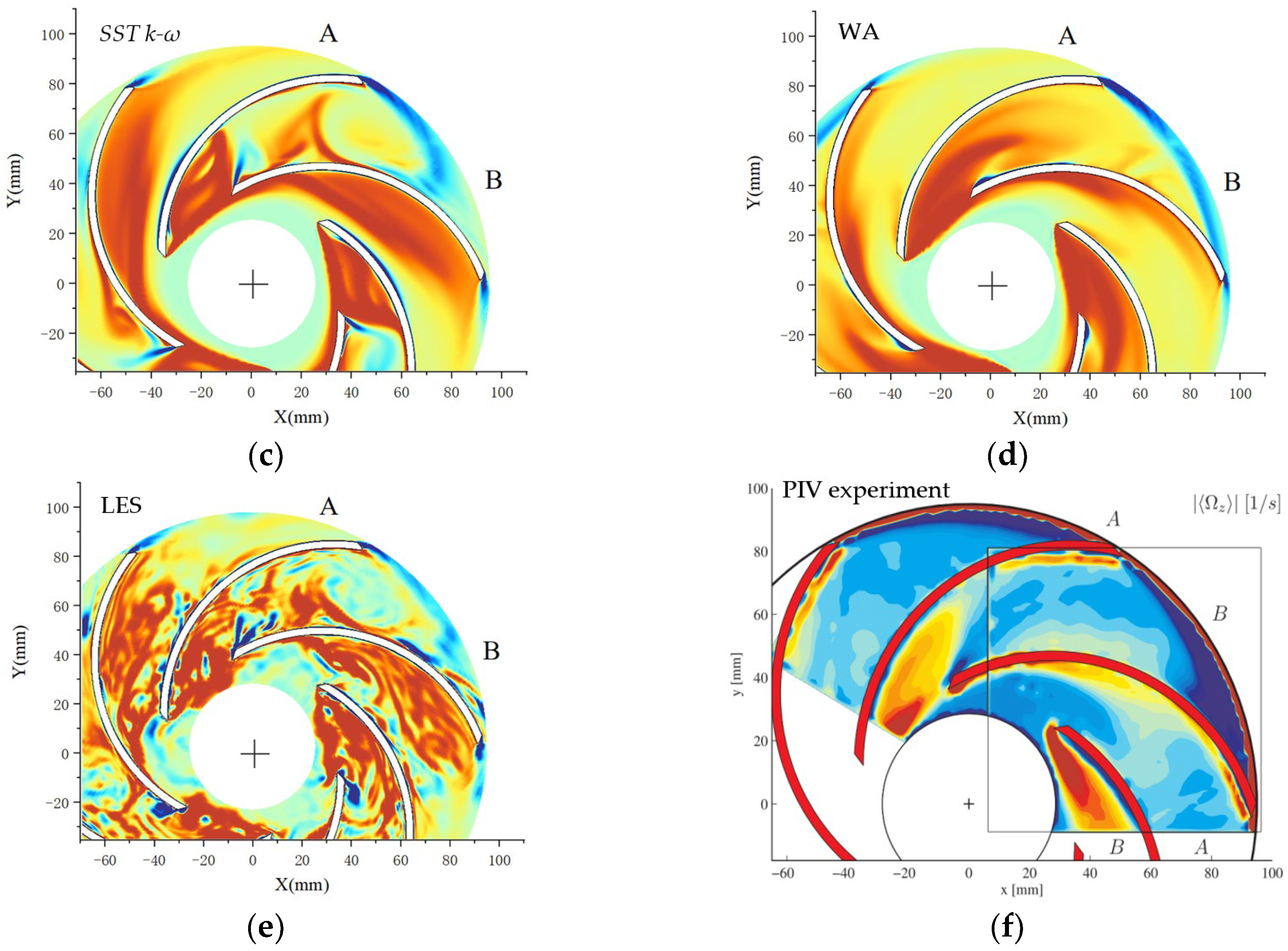
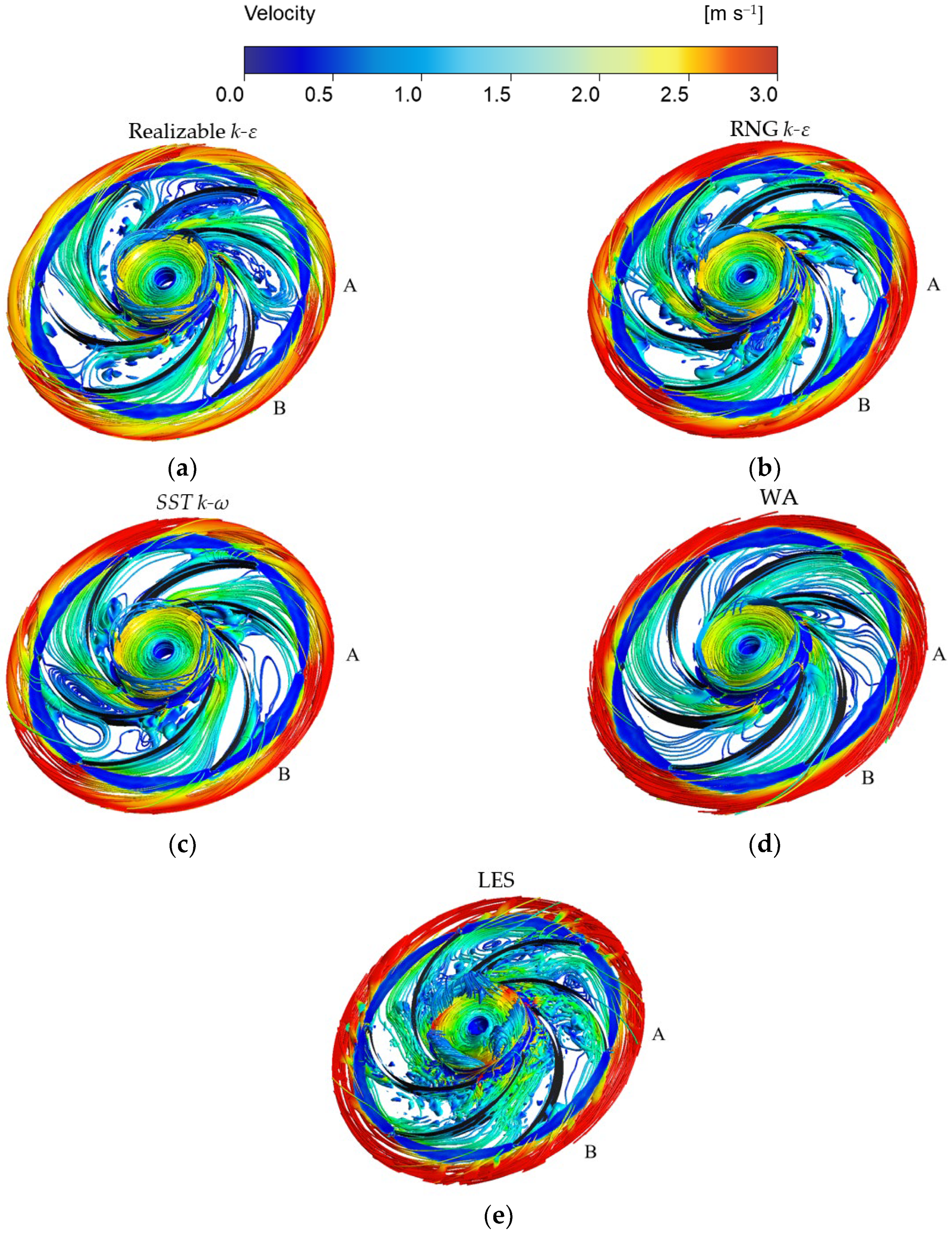
| Constants | Value |
|---|---|
| 0.0829 | |
| 0.1127 | |
| 0.72 | |
| 1.0 | |
| 0.41 | |
| 8.54 | |
| 8 |
| Geometric | Symbol | Value | Unit |
|---|---|---|---|
| Number of blades | Z | 6 | − |
| Inlet blade angle | β1 | 19.7 | ° |
| Outlet blade angle | β2 | 18.4 | ° |
| Blade thickness | t | 3.0 | mm |
| Specific speed | ns | 96 | − |
| Design flow rate | Qd | 3.06 | L/s |
| Design head | H | 1.75 | m |
| Rotational speed | n | 725 | r/min |
Disclaimer/Publisher’s Note: The statements, opinions and data contained in all publications are solely those of the individual author(s) and contributor(s) and not of MDPI and/or the editor(s). MDPI and/or the editor(s) disclaim responsibility for any injury to people or property resulting from any ideas, methods, instructions or products referred to in the content. |
© 2023 by the authors. Licensee MDPI, Basel, Switzerland. This article is an open access article distributed under the terms and conditions of the Creative Commons Attribution (CC BY) license (https://creativecommons.org/licenses/by/4.0/).
Share and Cite
Bai, L.; Hu, C.; Wang, Y.; Han, Y.; Agarwal, R.; Zhou, L. Evaluation of Various Turbulence Models and Large Eddy Simulation for Stall Prediction in a Centrifugal Pump. Water 2023, 15, 3432. https://doi.org/10.3390/w15193432
Bai L, Hu C, Wang Y, Han Y, Agarwal R, Zhou L. Evaluation of Various Turbulence Models and Large Eddy Simulation for Stall Prediction in a Centrifugal Pump. Water. 2023; 15(19):3432. https://doi.org/10.3390/w15193432
Chicago/Turabian StyleBai, Ling, Chen Hu, Yuqiang Wang, Yong Han, Ramesh Agarwal, and Ling Zhou. 2023. "Evaluation of Various Turbulence Models and Large Eddy Simulation for Stall Prediction in a Centrifugal Pump" Water 15, no. 19: 3432. https://doi.org/10.3390/w15193432
APA StyleBai, L., Hu, C., Wang, Y., Han, Y., Agarwal, R., & Zhou, L. (2023). Evaluation of Various Turbulence Models and Large Eddy Simulation for Stall Prediction in a Centrifugal Pump. Water, 15(19), 3432. https://doi.org/10.3390/w15193432









